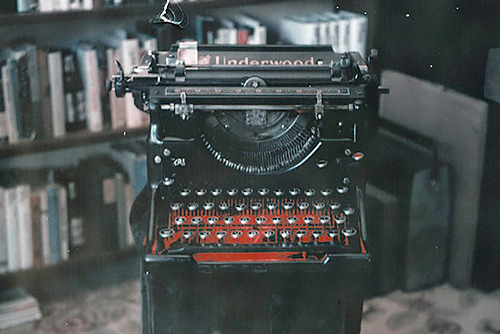Photo Corners headlinesarchivemikepasini.com
![]()
A S C R A P B O O K O F S O L U T I O N S F O R T H E P H O T O G R A P H E R
![]()
Enhancing the enjoyment of taking pictures with news that matters, features that entertain and images that delight. Published frequently.
Two Old, Inspiring Polaroids




16 May 2016
As we were scanning our Polapan slides the other day, we recalled with some alarm that for many years now we've had a couple of color Polaroid prints propped up on our bookshelves. They don't get direct sun but time takes its toll anyway.
So we thought we'd scan them on the CanoScan 9000F just to preserve them, if nothing else.
They'd escaped preservation before because we never thought of them as anything but test shots. That's because they were test shots. We were testing two things in the 1980s when we shot them: using colored filters on a flash and using that flash remotely.
We had decided to make up an assignment, much as if we were at school, to test those two things. And what better approach than to use a Polaroid camera to get instant feedback?
The first step was to pick a theme we could illustrate with those techniques. Writing. In one shot we would show the Flash of Inspiration. In the other we would show the Hard Work of Revision.
We knew about both.
INSPIRATION
For Inspiration we uncovered our old Underwood, we which had salvaged from the weekly magazine equipment morgue long after it had been replaced by snazzy IBM Selectrics. We outfitted a Vivitar 283 with a red filter and a Wein peanut slave, tucking it under the keyboard.

Inspiration. Fire-breathing keyboarding.
Our camera was a Polaroid 450 with a Type 108 color film pack similarly recovered from the art department of a print company's dust bin of history and, no doubt, a pristine flash cube. The 450 used its focus mechanism to open or close louvres on the flash cube to adjust the amount of light. It was an ingenious alternative to through-the-lens flash.
The on-camera flash triggered the remote Vivitar which, in turn, fired a red light into the keyboard.
A minute later we had a print. Which inspired us to continue our tests.
PERSPIRATION
For Perspiration we opened an antique writing box on our drawing table and set up some sheets of paper. Some of the paper was blank, some had handwriting on it and some was simply crumpled up.

Perspiration. Revision, rejection, reworking.
This time we used multiple exposures, each with a different colored filter on the flash to suggest we weren't working in stone but revising, rejecting and reworking the text.
We wanted to show some chaos, some desperation and just a hint of success.
A minute later, there was the print. Suitable, we thought, for framing.
FRAMING
But framing costs money and we had sunk our money in Type 108 film and pristine flash cubes.
So we came up with a simple way to frame these two images using the film packs themselves. We recall having to take them apart first to flip the inside piece around, reinserting it into the cover piece so the print would be supported in the window previously used to expose the film.

Framed. The metal film pack does the job.
That has worked well for years, though it doesn't provide any protection from ultraviolet light.
THE REAL TEST
They were only test shots. But they have sat on our shelves, looking down on us for years and years, whispering their messages. They've become something more than just test shots.
They've become a reminder that you have to have some to say if you want to write and you have to some perspective to edit what you write into something worth other people's time.
And as just such reminders, these tests have stood the big one: the test of time.